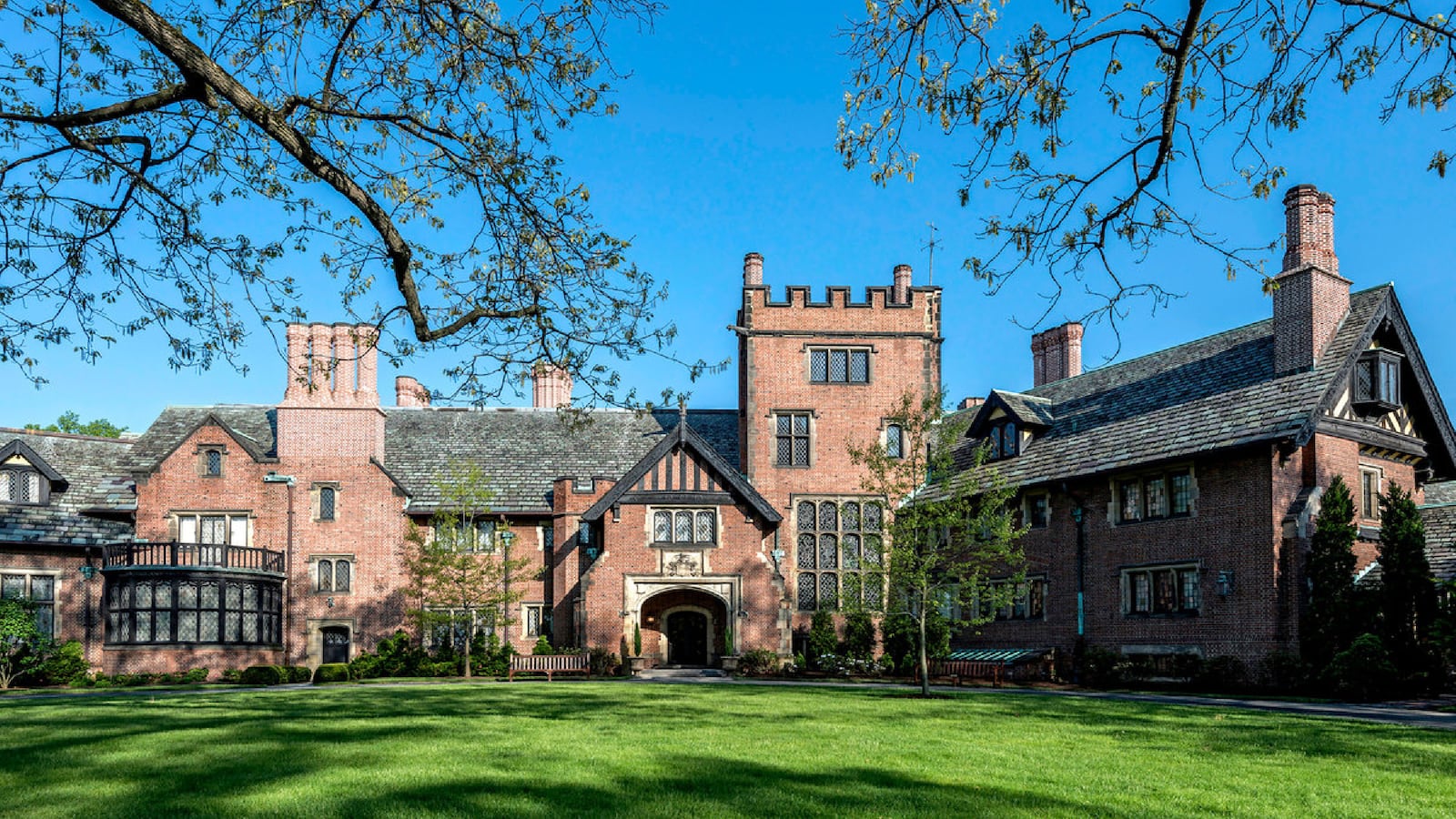You know a few of the largest homes in the United States already: the Biltmore, Hearst Castle, the Breakers, and the other celebrated dwellings. The remainder are largely where you might expect, on the Gold Coast of Long Island, around the Philadelphia Main Line, on assorted shores and promontories friendly to Gatsby types. A number are just memories, or now owned by universities or country clubs, as even Vanderbilt and Hearst or Dupont or Rockefeller heirs often balk at the expense of keeping up 100-room homes.
One you can visit right now is in a more unexpected place: Akron, Ohio, where the 65-room (18 bedroom) Tudor Revival Stan Hywet Hall remains in superb condition and has operated as a house museum since the mid-1950s. It is a relic of the golden age of American estate construction, completed in 1916 for F.A. (Frank) Seiberling, the co-founder of Goodyear Rubber company, and his wife Gertrude Penfield Seiberling. There was never a Stan Hywet living there, the title is an old English word for stone quarries, some of which dot the property (and one of which was repurposed into a charming Japanese garden).
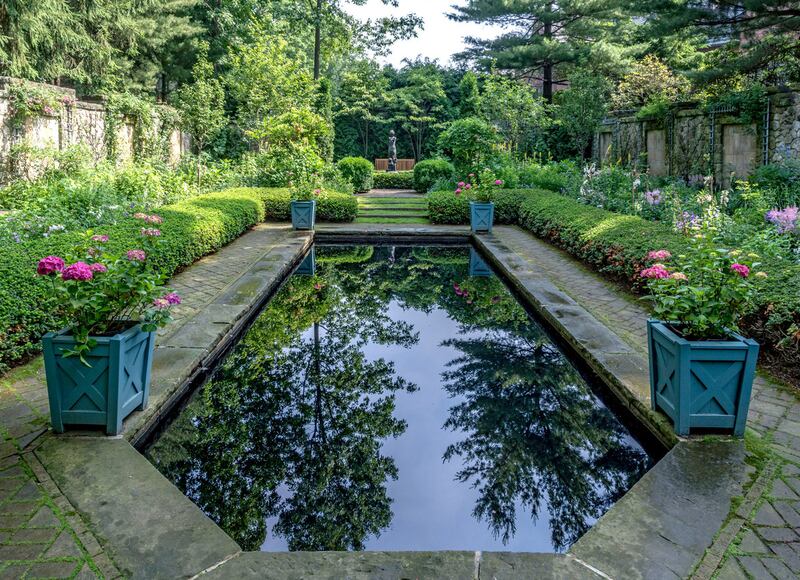
Economic fortunes have been much crueler to Akron than they have been to most areas holding immense homes but the house remains in excellent shape, looking better than ever (or at least its best in the last century or so thanks to recent waves of renovation). Many manor houses that are still around have lost much of all of their furnishings to offspring or auctions but Stan Hywet contains about 95 percent of its original contents, located as near to their original spots as any evidence can direct.
So don’t wait around for an invitation from the Rockefellers or a summer in Newport for a glimpse into the Gilded Age. William Howard Taft and Helen Keller visited (her thank-you note remains); you can, too.
Akron’s foundational role in tire development arose at a precisely fortuitous moment, just before the rise of an invention that had a voracious appetite for tires: the automobile. Akron was the fastest-growing city in the United States in the decade from 1910 to 1920 with its population growing from about 70,000 to over 200,000, and this growth made more than a bit of money for the rubber tycoons.
The Seiberlings purchased a large property north of town and set out on a grand tour in England to figure out just what they wanted to build there. They visited over 20 estates, settling on three as specific inspirations: Compton Wynyates in Warwickshire, Ockwells Manor in Berkshire, and Haddon Hall in Derbyshire (which you’ve seen as Prince Humperdinck's castle in The Princess Bride, also in both the Zeffirelli and the Fukunga Jane Eyre films, and more).
Charles Sumner Schneider, a Beaux-Arts-trained Cleveland architect, built a number of halls for Case Western Reserve and numerous homes across the Shaker Heights-Cleveland Heights manor belt but nothing so large as Stan Hywet, an exceptional work. The exterior is a very skillful variation on Tudor themes, consisting mainly of brick with stone bays and accents, half-timbered gables and varied crenellation, and all sorts of delightful chimneys.
The interior, the work of New York designer Hugo Huber, is exquisite in its sheer variety: the aim was to replicate the multiplicity of styles that occurred naturally over centuries of remodeling in English manor houses. I like half-timbering, but too much can leave you half-bored. The range of rooms is a joy to pass through, with surprises around every corner. Some repeat decorative elements tie things together, with Tudor Rose, Scottish thistle and fleur-de-lis patterns recurring throughout. Some elements are near-identical replicas of items found in the trio of inspirational halls, others more impressionistic. It’s also decidedly not stodgy. Gertrude wanted an all-antique home, Frank wanted a bit more comfort, and the design was a compromise, integrating antiques and new furniture built to look old. The result is dignified but still comfortable.
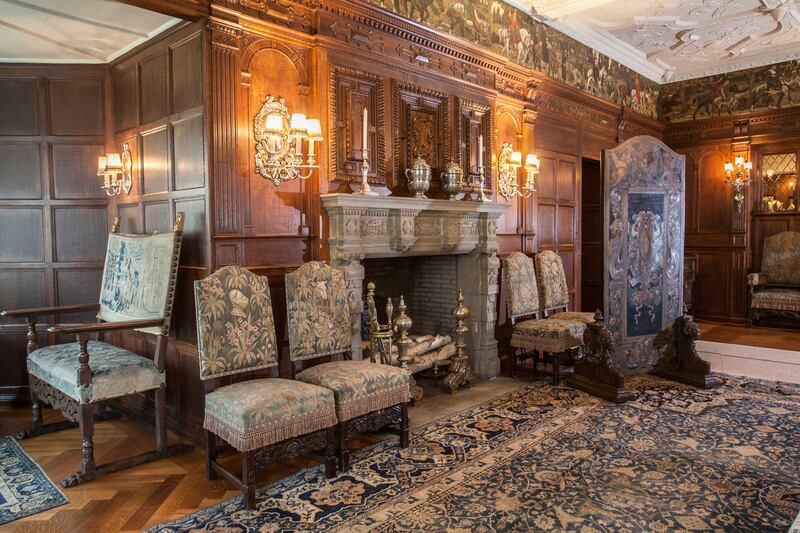
You can’t have a manor house without gardens, and the Seiberlings turned to one of the best landscape architects they could find, Boston landscape architect Warren Henry Manning. Manning worked for over a decade for Frederick Law Olmsted, contributing to the landscape of the Biltmore in Asheville and a wide range of park projects before launching his own practice. Manning unsurprisingly favored Olmsted-style naturalistic designs, and most of his scheme here is, but the Sieberlings wanted formal gardens around the house itself, and he created several beautiful ones. The design, one of his most extensive remaining,has been painstakingly restored over recent decades. Manning turned to a Chicago-based Japanese landscape designer T.R. Otsuka. for the Japanese garden. That’s still not all on the credits list: Ellen Biddle Shipman, one of the earliest female landscape architects, who created the Sarah P. Duke Gardens at Duke and a number of other spaces, redesigned the estate’s English Garden (on Manning’s recommendation) in 1929. Her scheme relied on an intense variation of smaller plants favouring milder shades of white, rose, pink, lavender, and yellow in contrast to bolder colours used more intermittently in Manning’s planting.
The Seiblerlings went all out on manor imitation, with a poultry farm on site, vegetable gardens, peach and apple orchards, and even an orangery (which has been rebuilt based on original designs).

These are usually things you read about when passing by a subdivision that replaced them. Gertrude died in 1946 and Frank in 1955 and their children donated the house to a foundation to operate the house as a museum shortly thereafter. Keeping up neo-Tudor appearances is difficult even for bigwigs and especially for a non-profit in a region experiencing decades of deindustrialization. Local volunteers did their best for some time but various DIY gardening schemes prevailed for a while until more sustained efforts to restore the landscape to its original appearance began in the 1990s (it’s now the most-intact Manning design anywhere). The processes of returning to that look are unfailingly fascinating.
A trouble was that they had very few blueprints of the landscape or the specific items planted.
Tom Hrivnak, the Superintendant of Horticulture at Stan Hywet, explained: “We had hundreds of photographs. The detective work began when we would look at these photos and we would see something original.” There were other more impressionistic aids; older volunteers describing what apples tasted like from a given spot.
Hrivnak said there are some enduring ambiguities but the landscape is more than 80 percent true to original form. Some elements remained in great shape. A Birch allee wasn’t quite intact but has been restored from original rootstock. White Oaks have survived well, and the majority of Concord and Niagara grape vines are still around. However, juniper trees were widespread but are especially vulnerable to fungus (and still are) and were all gone; they aren’t coming back.
There are other scenographic elements that are a little harder to restore. Allees of London Plane Trees and Birch trees at the north and south sides of the house were designed to provide views from the house, but replanted elms aren’t yet quite tall enough to provide the desired period view from second story windows, but nature will in time restore that. Some of the vistas of nature are now less desirable, and would now provide views of homes or a shopping center and accordingly have been left overgrown at the property edges.
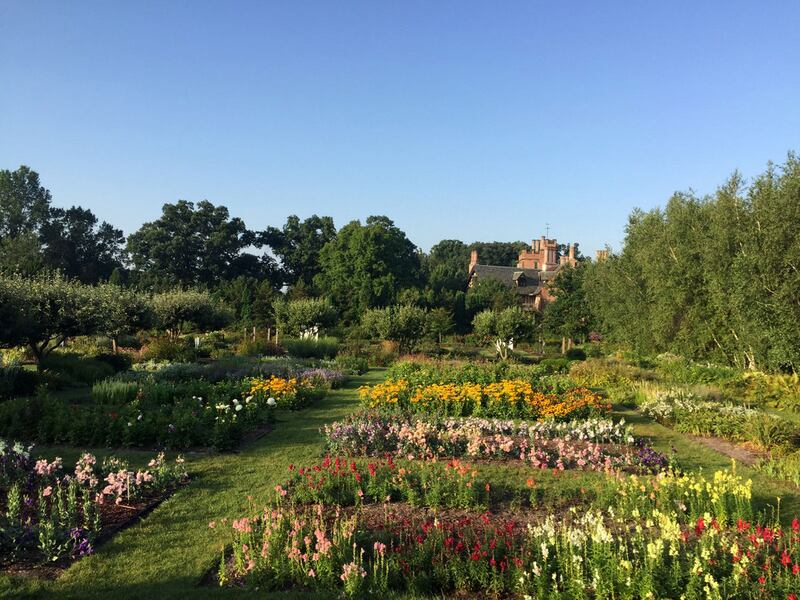
The gardens are an enchanting experience: the recessed Japanese garden (full of shrubs and dwarf trees, a waterfall, and a miniature Mt Fuji) makes superb use of a recessed small quarry. There are a number of outbuildings on the property, which the landscape skillfully conceals, and an almost-invisible recessed carriage drive. More formal spaces surround the house and more naturalistic gardens around those ease the transition to nature.
A 2020 American Gardens stamps issue featuring the estate’s Birch Allee. This is no simple task, with a staff of seven full-time and three seasonal employees and some 40 regular volunteers.
The gardens alone would be worth a trip but we also have a grand home at the center. The main hall is a replica of the great hall at Ockwells Manor, with permission from the lord and lady to copy their stained glass. Some rooms are quite Tudory. Guest bedrooms vary in decor, with Adams, William and Mary, Cromwell, and Colonial chambers. Rare woods, skillfully panelled , arranged, and carved vary from chamber to chamber. There’s American oak in many rooms, black walnut in the library (also a secret door in the cases, naturally), teak in the solarium, chestnut in the billiard room. Ceilings vary from mold plaster to coffered to half-timbered, ensuring that no view is ever tedious.
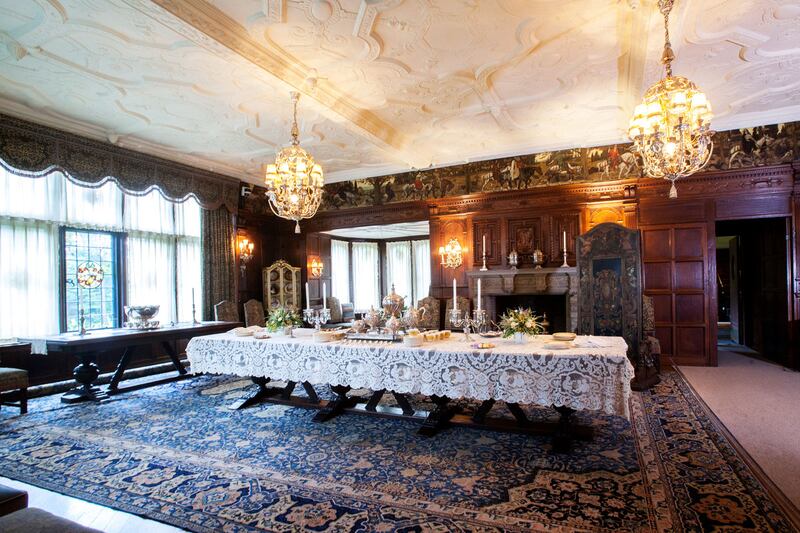
The music room is a captivating space at one end of the home, containing an Aeolian organ still heard often, and was once the scene of frequent concerts (some by Gertrude, a trained contra-alto who once performed at the Taft white house) and still sometimes is. It features an immense “Tree of Life” rug woven in India, a colossus that’s been a challenge to move ever since, Julie Frey, the curator, noted, “When we do roll it up for events we can’t even carry it out.” Two large tapestries credited to Leon Van Der Hecht from circa 1700 depict the goddess Pomona surrounded by summer fruits and the goddess Ceres with the yield of harvest season.
The dining room is suitably vast, eventually hosting Christmas dinners for 80 to 90 by the 1940s (easy to do when you have 22 grandchildren, eight still alive today). A frieze by Robert Sewell (whose commissions also included work for the St Regis hotel in New York City) depicting scenes from The Canterbury Tales lines the walls. I’m sure you can pick out more scenes than I did.
One of the most pleasant rooms in the house is the West Porch, which contains a stunning Pewabic tile fountain based on Robert Southey’s poem “The Well of St. Keyne.”
Furniture throughout provides endless interest: antiques share space with newer pieces and some hover in between. One settee frame was built and then upholstered with a tapestry portion.
There’s enough room for every sort of preference. The billiards room adjoins Frank’s office, with a separate entrance for guests. A walk-in safe could be opened via a button from Frank’s desk, a source of amusement for grandchildren. The home has a flower-arranging room, as I’m sure yours does.
The house was built to look old but contains all sorts of then-modern features: two phone booths, a relic of the point of construction when two competing phone companies had grids that did not connect; no prime industrialist could only talk to half of the town. There’s an internal telephone system with 30 extensions, and an internal vacuum system. Even cookery was versatile, with wood, coal, and gas cooking available.
The back-of-house space is considerable and often striking. The kitchen’s color scheme was altered to suit several tiles depicting medieval cookery found in New York. There are of course numerous servant’s quarters on the top floor. The home always employed a cook, laundress, butler, housekeeper, maids, and even more lodged elsewhere on the property around the gatehouse, the stables, and more. Even in later years somewhat less prosperous years of the Seiberling’s life they still employed a cook and laundress (Gertrude, legend has it, never learned to cook).
While it seems any number of visits would be inadequate the home holds a new exhibit each year as a return draw, with this year’s focusing on a recent six-year $1.2 million campaign to restore and renovate 15 ground-floor spaces and return the rooms to their 1915 appearance.
This has involved quite a lot of work. Many fabrics were worn out; some were removed due to fragility or remain only in fragments. Lampshades were scorched over time by incandescent bulbs. Replacement has been greatly aided by 3D printing directly onto textiles. Wall sconces in the music room contained over 400 crystals, all unstrung and laboriously replaced and rearranged. A thorough cleaning of one marble floor assumed to be black revealed the actual shade as deep red.
Much was in excellent shape. Frey noted that air conditioning is usually assumed to be essential but that in many older homes objects are actually acclimated to seasonal changes; air conditioning can actually warp woods.
Some elements are interesting in their absence. While the house is full of antiques and art the Seiberlings weren’t art collectors, collecting nothing of unusual repute. There are other great more improvisational touches remaining. Fred drew a cartoon of Kaiser Wilhelm in one recess above a fireplace upon return from service in World War I in a panel on a bedroom wall. Grandson John F. Seiberling Junior (later a Congressman from Ohio who served on the House Judiciary Committee during the Nixon impeachment hearings and after whom the Akron Federal Courthouse was named) later drew Hitler in an adjoining panel.
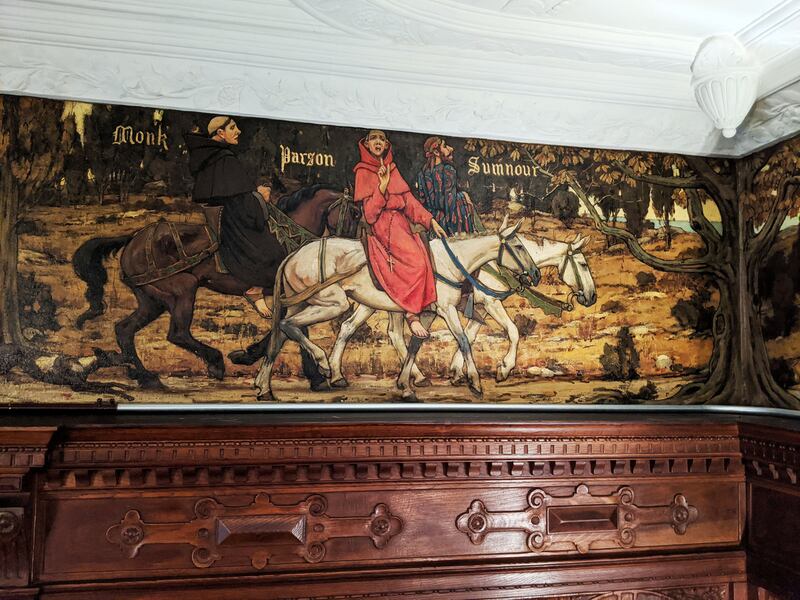
The basement contains a large pool that’s uniformly 8 feet deep. Frey explained, “it’s called the plunge because it has no shallow end.” There’s also a full-sized gymnasium.
There’s another considerable story at the gatehouse, which furnished a way out of troubles for many. Henrietta Seiberling, the wife of the oldest Seiberling son, brought Bill W and Doctor Bob together there, the effective foundation of Alcoholics Anonymous.
An inscription over the main entrance of the home bears an original family motto, Non Nobis Solum (“not for us alone”) and indeed it isn’t. Take a look whenever you can.
